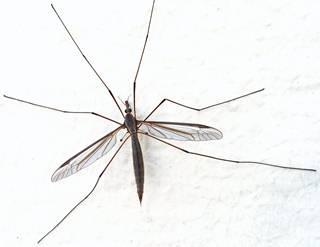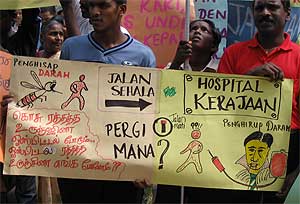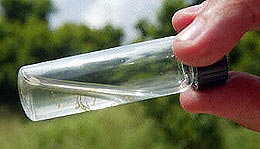In the letter “ GM Mosquito: Stringent protocols in Place ” of Nov 9, 2010, Madam Yamuna Perimalu, writing on behalf of the corporate communications unit of the Ministry of Natural Resources and Environment, describes the lengthy (5-year) process that has occurred to develop the present proposal to release Living Genetically Modified (GM) aedes aegypti mosquitoes in Pahang (Bentong district) and Malacca (Alor Gajah and Malacca districts) and attempts to assure us that all issues raised have been thoroughly addressed.
 It should be pointed out that the Malaysia Biosafety Act was only approved in 2007 and only came into force in 2009. What safeguards were in place during the unregulated years?
It should be pointed out that the Malaysia Biosafety Act was only approved in 2007 and only came into force in 2009. What safeguards were in place during the unregulated years?
The development of a GM mosquito is certainly a scientific and technological tour-de-force and the accomplishment needs to be appropriately recognised as such. However, what is most disturbing about the present planned release of GM aedes aegypti mosquitoes is the lack of information and further approvals associated with the proposed release as outlined below.
1. Why is the Ministry of Natural Resources and Environment spearheading this undertaking? Doesn’t mosquito and mosquito vectored disease control fall under the purview of the Ministry of Health? Why is the Ministry of Health silent in this entire matter?
2. What commercial entity is undertaking this endeavour and who are the individuals involved? There has been no disclosure of what and who is supporting the GM mosquito and its release (other than the Institute for Medical Research, IMR).
Who is going to produce the GM mosquitoes, who will release them, who will account for them and who will assume responsibility for any untoward events that occur? When it comes to larger scale release, billions of male mosquitoes will be required to be released – who will produce them and be accountable?
3. In the United States, any release of a genetically modified organism that involves humans requires an Institutional Review Board review of the proposed release and signed informed consent of all individuals exposed to the genetically modified organism.
How will informed consent be obtained from all individuals potentially exposed – not just from a few isolated individuals – or are Malaysian lives not nearly so dear to our government? And shouldn’t the review committee include Institute of Medical Research and the University that has an entomology department such as Universiti Putra Malaysia and the vector division, Ministry of Health to offer the opinions and advice?
4. The GM mosquito is designed to control wild mosquitoes that are classified as a “pest”. All materials engaged for the control of mosquitoes are consequently classified as “pesticides” and require registration and approval from the Malaysia Pesticide Board. There is no mention that such registration and approval has been requested or obtained.
5. Mdm Yamuna states that the USDA has approved the release of the GM pink bollworm and the GM fruit fly. This is true. However, these are agricultural pests and are not a threat to human health. To imply that the same level of criteria should be applied to GM mosquitoes, a known human blood feeder and human disease vector vastly oversimplifies the safeguards that need to be considered.
6. Mdm Yamuna further cites other countries, including India, as evaluating the GM mosquito. India has recently rejected the Genetically Modified eggplant – does the Ministry of Natural Resources and Environment really believe that India will then accept the GM mosquito?
7. It is stated that this is only the first step in a multi-step process of approval and is for only the proposed “limited” field trial. How long will the overall process require and how will dengue be controlled in the interim – how many Malaysians will become sick and how many deaths will occur?
8. Under Malaysian law, it is illegal to harbour, rear or propagate mosquitoes. With the GM mosquito, these activities are clearly occurring. Has the concerned business and people obtained an exemption from this law?
9. Are there other competing technologies that can also be considered, that are effective at controlling dengue-carrying mosquitoes?
The above are only specific questions regarding the release of GM aedes aegypti mosquitoes.
Communities involved must give consent
There are further more general questions (as described in the UNDP/World Bank/WHO Special Program for Research and Training in Tropical Diseases (TDR) publication ‘Ethical, Legal and Social Issues of Genetically Modified Disease Vectors in Public Health’ by Darrel Marcer).
 1. Before field release of transgenic organisms, researchers must assess all the scientific and social issues associated with GM vectors and develop safety precautions to address potential risks.
1. Before field release of transgenic organisms, researchers must assess all the scientific and social issues associated with GM vectors and develop safety precautions to address potential risks.
2. The scientific and social risks should be minimised through careful design of the vector system, relevant laboratory experience, and careful choice of site including consideration of appropriate social and cultural factors.
3. Even if there are no perceived realistic risks, a procedure for their evaluation should be set up so that new information can be gathered and interpreted. This procedure may involve establishing a specialised ethical review committee to offer advice to researchers seeking guidance on the ethics of projects.
4. There should be prior environmental, medical and social studies for site selection, and the most appropriate site should be chosen based on the data obtained.
5. Information should be openly exchanged as broadly as possible to relevant community leaders, members of the community, and mass media. This needs to be done with international collaboration.
6. Consent should be obtained from the communities involved. Specific mechanisms for this need to be developed and will be useful for other areas of public health interventions.
7. A contingency plan for aborting field trials needs to be developed. One approach is to engineer a lethal gene for the vectors that can be induced by a non-toxic chemical to ensure total elimination of those that have acquired the genetic construct.
8. Commitment to the local communities involved in field trials should be made that they will be the first beneficiaries of more permanent use of a GM vector should the results indicate that its use is appropriate.
9. Intellectual property concerns should not be barriers to implementation of public health measures using GM vectors or their symbionts and/or pathogens. Prior negotiation, including possible involvement to allow access to the latest technology, is preferable to confrontation.
10. To avoid any suspicion by the public that could result in their rejection of this approach, governments should not involve partners from military research establishments in the projects.
11. The data should be open to all in order to benefit from global expertise and develop international consensus.
12. Whatever guidelines are developed, they should be revised as experience with genetic engineering technology grows, as knowledge of ecology and communities grows, and with societal trends.
Dr Marcer further emphasises that an international approach is required since vectors do not honor national borders, nor is their behavior always predictable.
Has the Ministry of Natural Resources and Environment fully followed all of these suggested guidelines?
Simulations not sufficient
No consideration of mosquito mating behavior and dengue virus transmission is reported by Madam Yamuna or the Ministry of Natural Resources and Environment. Mosquitoes have a complex mating behaviour which requires the male and female mosquito to come within 1 inch (2.54 cm) of each other before their wing beats harmonise in their mating ritual.
 How will the laboratory-reared GM mosquito find its wild female partner? In the wild, the adult male mosquito emerges before the female and remains nearby so that when the females emerge, they can go and obtain a sugar (nectar) meal before host-seeking and mating. The GM mosquito has no clue where the wild females are. How will they find them – by sheer chance?
How will the laboratory-reared GM mosquito find its wild female partner? In the wild, the adult male mosquito emerges before the female and remains nearby so that when the females emerge, they can go and obtain a sugar (nectar) meal before host-seeking and mating. The GM mosquito has no clue where the wild females are. How will they find them – by sheer chance?
Madam Yamuna reports that simulated, contained field trials have successfully been carried out. At best, this is an artificial situation that bears no relation to the real world. When mosquitoes are contained in a closed environment, they have no choice and will eventually find each other and produce the expected result. In the wild, there is no containment and the likelihood of the GM male mosquito finding a wild female partner is dramatically reduced.
The dengue virus not only infects the salivary glands of the adult female aedes aegypti mosquito, but also the ovaries and eggs. When the eggs are laid, they are infected with dengue, which persists through the larval and pupae stages. Consequently, when the adult females emerge, they are already dengue positive and transmit the virus on their first (human) bite.
Even if they mated with the GM male Aedes aegypti mosquito, the wild female mosquitoes will still be positive for dengue and transmit the disease throughout their adult life cycle. Further, the wild male mosquitoes from the dengue infected eggs will also transmit the virus to any uninfected wild female mosquito that they mate with, thereby propagating the dengue virus to subsequent generations.
The GM adult male mosquito will soon die – usually within 3 days. How many mosquitoes, at what frequency of release and for what period of time will be necessary to control dengue with the GM mosquito?
What if it transmits HIV?
There is a famous quotation from the late Professor Andrew Spielman then at the Harvard School of Public Health:
“No animal on Earth has touched so directly and profoundly the lives of so many human beings. For all of history, and all over the globe, she has been a nuisance, a pain, and an angel of death. The mosquito has killed great leaders, decimated armies, and decided the fate of nations. All this, and she is roughly the size and weight of a grape seed” – from the Preface to Mosquito by Andrew Spielman and Michael D’Antonio (Harvard).
Since the mosquitoes are genetically modified, there is a high probability of it causing a new borne disease in the future and it is advisable not to disturb the natural eco system. Malaysia had its first dengue outbreak in Jinjang, Kuala Lumpur in 1972. Before that, it was unheard of and basically, the aedes mosquito had developed the new strain of disease.
There are many unknowns and unanswered questions concerning the GM mosquito. Science is very good at obtaining answers to posed questions. How do we know that we are asking the correct questions? In science, it is the questions that are not recognised and unasked that lead to the greatest problems.
For thousands of years, mosquitoes have been very clever at devising ways to overcome whatever mankind has thrown at them. What assurance can be provided that that is not the case with the GM mosquito? What would happen, for example, if the GM mosquito were to acquire the ability to transmit the Human Immunodeficiency Virus (HIV/AIDS)?
What assurances can the unidentified business and people provide that this will not occur? What would happen to the Malaysia tourist industry if some unanticipated consequence resulted from release of the GM mosquito – would other countries ban travel to Malaysia – would Malaysian’s be banned from traveling to other countries? What would the economic consequences be – both for tourism and industry if that scenario arose?
The mosquito is quite literally the Most Dangerous Animal on the Planet! What is being proposed is the release of mankind’s most mortal enemy. Can Malaysia afford to take that risk?

